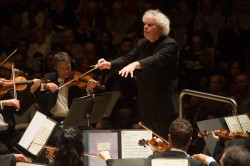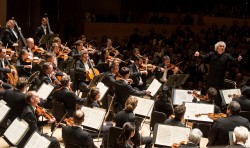![]()
 The renowned Berliner Philharmoniker (BPO) stopped by Roy Thomson Hall November 15 and 16 for two concerts as part of a seven-city North American tour under Sir Simon Rattle. Rattle is leaving his post in September 2017 after 15 years as principal conductor and this tour is his last in that capacity. We in Toronto are indeed fortunate to have had the opportunity to experience his wondrous instrument comprised of more than 130 players. Their unsurpassed individual skills notwithstanding, it is their collective whole and how it is shepherded by Rattle, how he kneads it, shapes it and inspires it that we hear and see. It’s a question of unerring balance, where the brass doesn’t outshine the strings; and of transparency, where individual players make a strong contribution to the overall sound.
The renowned Berliner Philharmoniker (BPO) stopped by Roy Thomson Hall November 15 and 16 for two concerts as part of a seven-city North American tour under Sir Simon Rattle. Rattle is leaving his post in September 2017 after 15 years as principal conductor and this tour is his last in that capacity. We in Toronto are indeed fortunate to have had the opportunity to experience his wondrous instrument comprised of more than 130 players. Their unsurpassed individual skills notwithstanding, it is their collective whole and how it is shepherded by Rattle, how he kneads it, shapes it and inspires it that we hear and see. It’s a question of unerring balance, where the brass doesn’t outshine the strings; and of transparency, where individual players make a strong contribution to the overall sound.
The two programs were brilliantly conceived; in fact, they could be read as one, centred around the music of Vienna in the first decade of the 20th century. Tuesday’s concert was devoted to Mahler’s 80-minute Symphony No.7 (1904/1905) with a brief but crucial opening work, Éclat for 15 instruments (1964-65) by Boulez. Wednesday’s consisted of Schoenberg’s Five Pieces for Orchestra, Op.16 (1909); Webern’s Six Pieces for Orchestra, Op.6b (1909 -- reduced version 1928); Berg’s Three Pieces for Orchestra, Op.6 (1913-15 -- revised version 1929); and Brahms’ Symphony No.2 (1877).
Rattle addressed the audience (RTH was at capacity including a fully occupied choir loft) before Wednesday’s concert providing some perspective while telling us that the 14 movements of the three works we were about to hear before intermission would be played without a break and requesting no applause. He asked us to imagine those three young composers in Vienna having heard, as many of us had done just the night before, the vast Mahler symphony, that harbinger of modernity. “What are we supposed to do after that?” he supposed they might be thinking. “The first half of tonight’s program is the answer -- a 14-movement suite or Mahler’s 11th symphony.”
The link between Mahler and the Second Viennese School trio is clear. As for Brahms, Schoenberg regarded him highly and analyzed his music when he taught composition, calling him “the progressive” who paved the way for the future of music.
There was an ever-present chronological push/pull in the Toronto concerts beginning with Boulez’s Éclat, Tuesday’s opening work, a clear outgrowth of the 14-movement suite that opened Wednesday’s. Boulez said that Éclat meant “splinter” or “fragment” and the piece begins with an “explosion” on the piano forcefully played by Majella Stockhausen, daughter of Karlheinz Stockhausen (who wrote his Klavierstück XII and Klavierstück XIII for her). The ten-minute piece is a showcase for live sound: sounds emerge and dissipate into silence then rebuild into a tonal roar mainly using keyboards, harp and percussion before winds, brass and strings reach a climactic tutti that diffuses at the finish. It’s a focus on tone colour, timbre and dynamics that reflects back on the Second Viennese School. That’s what made Rattle’s choice of it to precede Mahler’s Symphony No.7 so apt.
 The Mahler under Rattle (he conducted without a score) became a showcase for the marvellous musicianship of his orchestra. From the depth of trumpet pianissimos to the way the flutes floated above the strings in the opening movement; from the French horn duo and pointed English horn dialogue in the second, the way the “Night Music’s” mysteries were unveiled by the violins and woodwinds and the exposed flute and harp; the way the unhinged waltz crackled and cackled in the third movement as Rattle dug into Mahler’s sardonic side; the fourth (a second “Night Music”) was beautiful music beautifully played; while the fifth delivered over-the-top joy cloaked in martial underpinnings.
The Mahler under Rattle (he conducted without a score) became a showcase for the marvellous musicianship of his orchestra. From the depth of trumpet pianissimos to the way the flutes floated above the strings in the opening movement; from the French horn duo and pointed English horn dialogue in the second, the way the “Night Music’s” mysteries were unveiled by the violins and woodwinds and the exposed flute and harp; the way the unhinged waltz crackled and cackled in the third movement as Rattle dug into Mahler’s sardonic side; the fourth (a second “Night Music”) was beautiful music beautifully played; while the fifth delivered over-the-top joy cloaked in martial underpinnings.
Schoenberg described his Op.16 as “merely a bright uninterrupted interchange of colours, rhythms and moods,” a thought the Berliners actualized with aplomb. The first piece growled with excitement and fluttering colours while in the second the BPO’s diaphanous sound was exposed to brilliant effect.The third played up the atmospherics lurking below the surface while the scattershot fifth felt like listening to wild sound dialogue from a Robert Altman film (a good thing).
Rattle illuminated the Webern insightfully, its deconstructed brilliance served up on a platter by the orchestra’s brilliant ensemble work, all leading to a breathtaking conclusion. Berg’s Op.6 showcased the orchestra’s full resources, big and small, with emotional phrases long and short, culminating in the third piece’s Romantic tinges and Mahlerian trombones.
After the massive forces that preceded it, the concluding Brahms’ symphony felt like it was being performed by a chamber orchestra. It was masterful playing that brought a staple of the concert hall to life, its sumptuous lyricism an organic outgrowth of developmental pushes and pulls. It was a demonstration of how to build music architecturally with Rattle teasing the melody out of the second violins or bringing out the whispers, hints and glimmers that Brahms put in the score.
And at the end of each concert, Rattle walked through the orchestra to shake hands with the principal players, asking each to stand, and then inviting the supporting players to do so as well. It seemed so warm, convivial and civilized. After a final bow, the conductor left the stage, the orchestra members stood up, shook each other’s hands and walked off, leaving a standing ovation behind, suddenly truncated.



